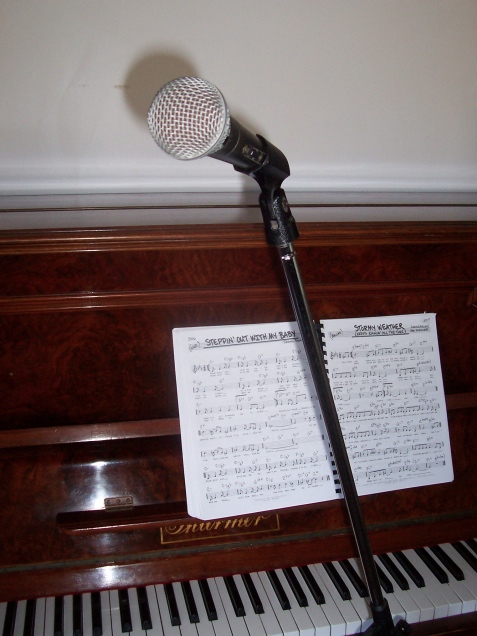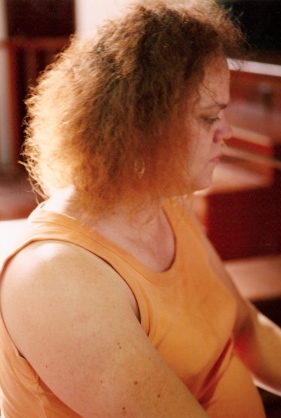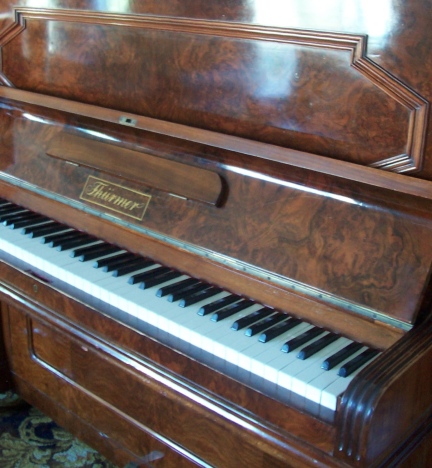
Tuition & coaching in voice (singing & speech), vocal health
piano, music theory, keyboard harmony
piano solo, piano accompaniment. Perth, Western Australia
Mx Margaret Dylan Jones
The Singing & Speaking Site
More About Vocal Lessons |


ON THIS PAGE: Solo Singing | Shared Lessons | Choir Singers | Styles of Music
Languages | How Long Does It Take? | Style of Teaching
Vocal Health | Techniques Taught | Protecting Your Voice
INTRODUCTION
Since 1981 I've been teaching piano and theory to a very wide range of students. The vocal side of my work, which began in 1988, soon dominated my teaching load, with voice students making up slightly more than half of my appointments.For more info about my background in singing, see How I Learnt About The Voice. On my qualifications page you can read about my first prizes in singing.
Most lessons are one-to-one, but I often teach two people at a time.
SOLO SINGING
Any style of music, beginners to advanced. Technique and voice care for any style or level.
I mainly teach pop, musical theatre and classical singing. Most of the non-classical students learn speech quality singing & Broadway belt. My students sing anything from Elton John to Nirvana, Blues, Jazz, Soul, Scarlatti & other classical.
SHARED SINGING LESSONS
So far this has always worked well for the first month or two of lessons. Find a friend!
CHOIR SINGERS
Do you have trouble with your voice at choir rehearsals? Pitch problems? Strain? Hoarseness? Range is difficult? Let's fix it so that you can once again gain pleasure from your choir! (Includes voice production, voice care & health.)
As a university student, I sang with many choirs. For many years I conducted a couple of adult beginner choirs, and also taught every member of those choirs before they were allowed to join. So, I'm sure I can help YOU if you are a chorister in need of assistance.Singing in a choir can be a wonderful experience but it can also be fraught with vocal complications. I'll sort it all out for you, no matter how complicated or obscure the problem. Back to top
STYLES OF MUSIC
Though my main background is classical, I have taught a large number of rock, pop and music theatre singers. And a few jazz singers. But make no mistake: my rock singers sound like ROCK singers, NOT classical singers.
Most of my students do non-classical music. They do originals, or covers like Leonard Cohen, Mariah Carey, Celine Dion, Aerosmith, Shania Twain, AC/DC, etc etc. All kinds of things, including rap and grunge! Some of these songs are very close to speech technique, and I teach speech technique so I can definitely help you there.
My classical (and musical theatre) singers do learn some of the same voice control and development techniques as the band singers, but the emphasis is completely different. And the songs and sound qualities are different, of course. Classical students learn vocalises, which are used to develop many different technical skills. These include vocalises for long notes, leaps, smoothness (legato), eveness throughout the range, and development of tone and agility.
Many of my classical and music theatre students have done very well in AMEB exams, and won prizes in local eisteddfodau. They sing lieder and art song, arias from operas, cantatas and oratorios, and other songs. Back to top
LANGUAGES
I teach songs in English, Italian, Latin and German. And I particularly enjoy French melodie/chanson, but I only do this repertoire if the student has already learnt a fair bit of French themselves. I have also taught singers with Chinese and Indonesian songs.
Each language has its own beauties and its own challenges. It must be remembered that, with any language, the way it is sung will occasionally differ from the way it is spoken (but try telling that to a language teacher, especially Italian!)
For more info about my language background, see How I Learnt About The Voice.
HOW LONG DOES IT TAKE?
I often get asked this question, which is pretty difficult to answer. If you want to be another Dame Joan Sutherland or Luciano Pavarotti, you're looking at six years just to get past the beginner stage. And you wouldn't do that with just the one teacher.
If you want to improve your Hall and Oats covers, well, you may find a big improvement after a couple of lessons. I have had new students tell me that the other members of their band thought they were singing much better after just the first introductory lesson. Usually, all students can expect very quick and very tangible results. In this day and age it shouldn't take months to fix obvious vocal problems.
STYLE OF TEACHING
A feature of my style is the development of the student's awareness, right from the very beginning. I work on the awareness of types of sounds, the feeling of the sounds, and the feeling of the various muscles of the vocal instrument. This is a very powerful way to teach, and probably explains why students often improve heaps after just a few lessons. Back to top
VOCAL HEALTH
With all my singers I spend at least a little time, sometimes a lot of time, working on pure vocal health. When you get that right it can make a tremendous difference to a singer, regardless of the musical style. See my Disclaimer for Voice Students.
TECHNIQUES TAUGHT
Breathing: sometimes "low" breath support, sometimes "diaphramatic-intercostal breathing" (D.I.B.), sometimes "splat" breathing, and sometimes "speech" breathing.Placement of sound. This gives you a much finer control of the resonance of the sound, and helps singing in tune.
Development of resonance, including the Singer's Formant.
Range extension, especially how to sing high notes more easily.
Efficient articulation. Consonants must be done super super easily, otherwise you're getting tense. Do them right and not only do the consonants sound great but your vowels are also improved.
Various voice qualities and voice maneuvers:
- Speech Quality Singing
- Speech Level Singing (a very different idea to SQS)
- Twang
- Broadway Belt
- Sob/Cry
- Opera
- Falsetto
- Larynx positioning (sometimes stable, sometimes high)
- Velar control (sensitivity and control of the soft palate)
- Tongue positioning (especially to avoid a retracted tongue)
The emphasis varies from student to student, of course. Some other factors I work on with singing students include:
- Passaggio (register or gear change): eliminating breaks, developing a 'connected' voice
- Tonal colour: variety, consistency
- Warm-up routine: stages, implementation
Other points to consider are articulation, intonation (fine pitch control), fluency and tempo, rhythmic control, nasality, stance, and head/neck relationship. Back to top
PROTECTING YOUR VOICE
- Retraction of the ventricular (false) folds
- Good speech technique
- Sometimes thinning of vocal folds (for high notes)
- Hydration (vocal folds MUST be moist at all times)
- Relaxation techniques.
I usually spend time talking with students about the many other issues that might be having an effect (good or bad) on their voice, quite apart from how they are using their vocal mechanism. Some students need to look at these issues in depth.
A DEDICATED TEACHER
If you gather from all this that I'm really more interested in teaching than in performing, you're quite correct. But I don't have any problem performing, either as a pianist or as a singer. I don't get nervous or anything like that, and I quite enjoy the experience.
But what really gives me a buzz is TEACHING, and COMPOSING.
Mobile phone: 0414 374 701.
(Outside Australia: +61 414374701).
Email: see my contact page.
Vocal Lessons
The Singer's Formant
How I Learnt About The Voice
More About Vocal Lessons
Speech Restoration
Reviews & Resources Disclaimer
The Piano Pages
